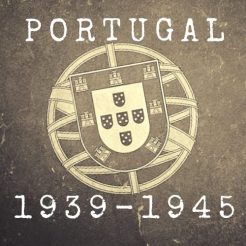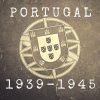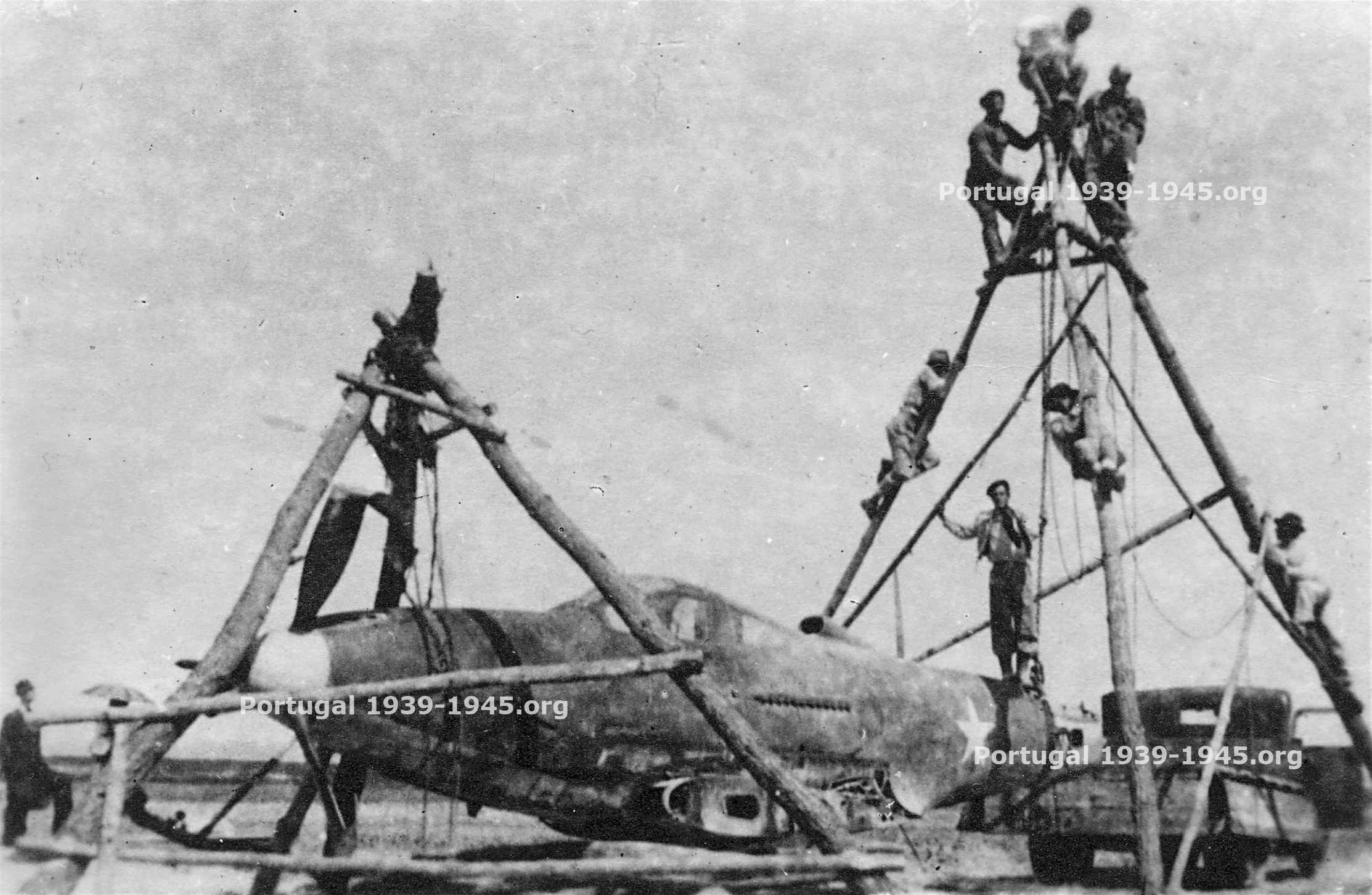
Airacobra being loaded to be transported to Lisbon
(Picture: Associação de Defesa do Património Histórico e Arqueológico de Aljezur)
Date
Location
Force
Aircraft
From-To
Crew
03-06-1943
Aljezur - Pego das Aguas
USAAF
Bell Airacobra P400 BX187
Portreath (GB) → Port Lyautey (Marroco)
Lt Richard Savoy USA
The Airacobra P-400, from the 12th Air Force (USAAF), took off from the Portreath airfield, in the United Kingdom, as part of a group that included bombers as guides bound for Port Lyautey, in Morocco.
Richard Savoy was close to the Portuguese coast when the engine started to fail. Faced with this difficulties, he looked for a location to make an emergency landing and, still over the sea, released the supplementary fuel tank under the wings, anticipating that he might not find a place with the best conditions to land.
Once over land, he made several passes at low altitude over the Rogil area, a small village, in the municipality of Aljezur, to identify a place where he could land. Already in difficulty, he saw a terrain that seemed flat and long enough to do it. He landed in the middle of a sandy and irregular cornfield, breaking the landing gear and damaging the nose rotor, flaps and propeller. The impact was violent and Savoy hits his head on the control panel, briefly losing consciousness.
The plane's flight over the village aroused a mixture of concern and curiosity. Manuel Maria Canelas and António Novais Henrique, aged thirteen and six, respectively, were among those from Rogil who witnessed the evolution of the aircraft and the troubled landing.
Feliciano Arsénio and his wife - Maria José Susana - were farming at Pego das Éguas and got a huge scare when they saw the plane stopping a few meters away, raising a huge cloud of dust and making an impressive noise.
The experience of both - already deceased - is remembered by their daughter, Helena Glória Arsénio, who heard her father tell the story several times.
Feliciano was the first to reach the plane helping Savoy out of the Cockpit. Still stunned by the blow to the head, he tried to communicate uttering a few words in English that Arsénio obviously didn't understood. Desperate, he took a handful of earth and, with a few gestures, manages to made himself understood, obtaining the information that he had landed in Portugal.
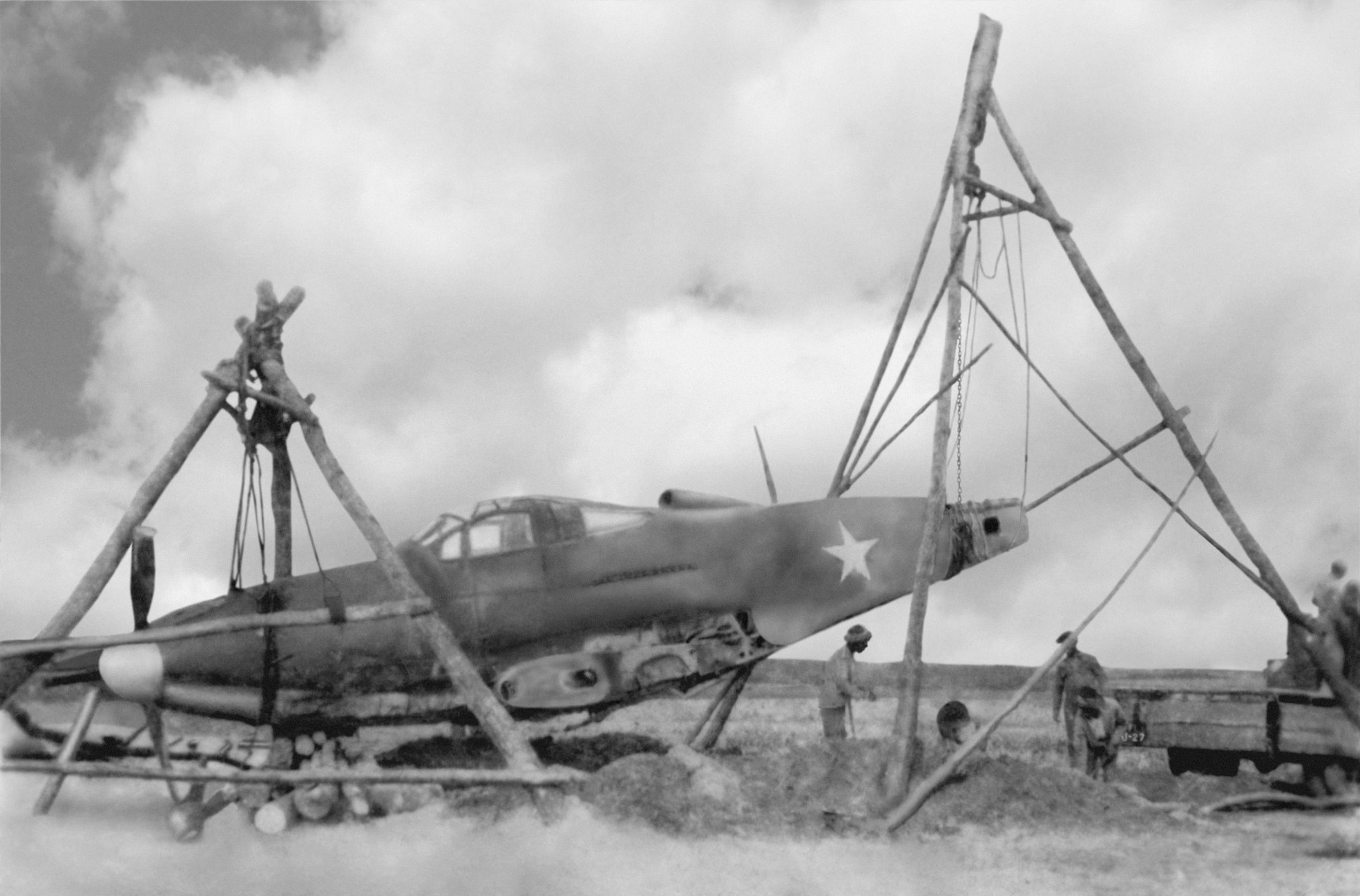
The P-400 being prepared for transport to the Ota base in 1943
(Photos: Assoc. Def. do Patr. Histórico e Arqueológico de Aljezur)
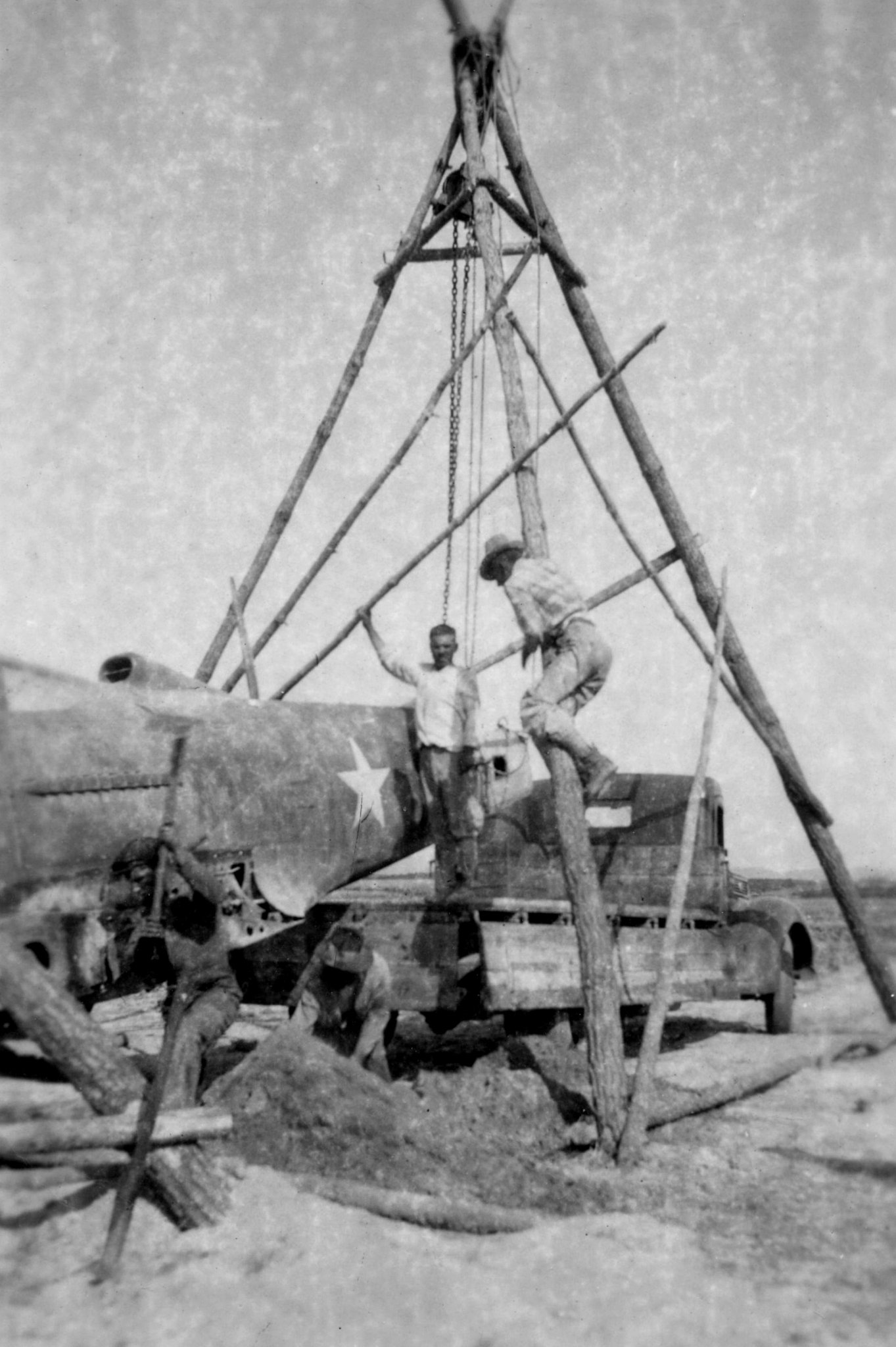
Savoy appeared calm. Landing in Portugal is safer for Allied airmen and returning to their respective units usually happens faster, unlike a landing in Spain, which could lead to indefinite detention.
Although in neutral and friendly territory, he didn’t not ignore the security procedures and, by gestures and monosyllables, he asked Feliciano Arsénio to help him burn the documents on the plane, namely, the flight plan, maps and other papers that could denounce the missions objective. The Portuguese house was 300 meters away and had a bread oven. Feliciano accompanies the lieutenant to the oven, which was lit, so he could burn the paperwork.
Since June 16, 1942, the destruction of aircraft was not a priority safety procedure, as determined by the British Air Ministry. This determination was also adopted by American pilots and applied to landings in Portugal and its colonies, Ireland, Turkey, and South American states. The airplanes were a currency and exchange and could be bought by, or offered to the countries where they had landed. Aircraft and equipment considered secret or included in a specific list were excluded.
In Rogil there was no civil or military authority that could take care of the occurrence. According to Helena Arsénio, her father harnessed two of his mules, and each one mounted one, to go to Aljezur municipality council where he was handed over to the Mayor, Navy first-lieutenant Francisco Albano de Oliveira.
On the 5th, the commander of the military unit in Lagos gave orders to bring the airman to the city. He was handed over to the American military attache of the American Legation, who took him to Lisbon where he received medical treatment until the beginning of July, when he was interned in Elvas.
I do not know the date of his repatriation.
A difficult transport
The plane remained at Pego das Éguas under the supervision of the Fiscal Guard. The very next day, members of the Aeronáutica Militar (Portuguese Army Air Force) - Lieutenant-Aviator Enrique Dantas Maya and the support of the mechanic Bernardino Pereira - arrived at the site to coordinate the dismantling and transport operations.
The account of the strange journey that followed was given by the driver of the truck, Eliezer Augusto Quintanilha Mendonça, in an interview made in June 2003.
The dismantling of the plane and its laborious placement in the truck bed was completed on the morning of June 11th. After lunch, Eliezer and the two military personnel drove slowly to the village of Odemira, where they stopped to assess the the load, not only because of it’s weight but also because the length of the plane exceeded the truck for more than a bit.
It was almost night when they reached Alcácer do Sal, 170 km away, where Lieutenant Maya decided to stop for dinner and spend the night. The truck was parked next to the Bullring where soldiers from the National Republican Guard were posted on watch until the morning.
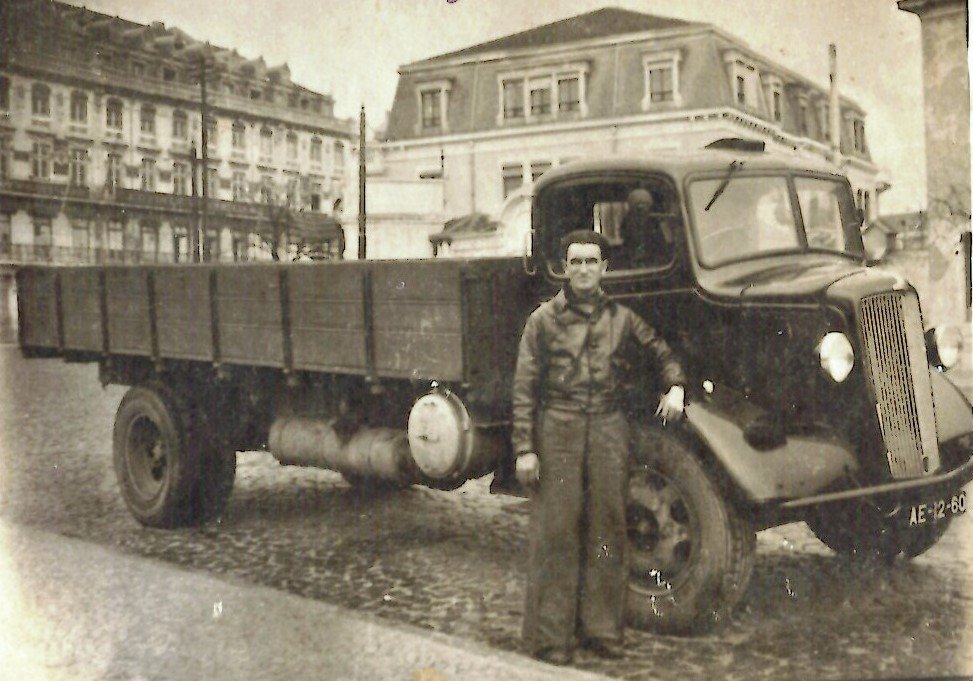
Eliezer Mendonça and the truck that transported the plane to the Ota base
(Foto cedida pela família de Eliezer Mendonça)
The next day they left for Cacilhas. The instability of the load made driving difficult and forced some stops for constant evaluations.
Getting the truck into the “cacilheiro” - the ferry that crossed the Tagus River - was difficult and time-consuming, in addition to arousing the astonishment and curiosity of passengers and sailors. Landing in Lisbon was also fraught with some difficulty, in particular, crossing over the pontoon between the boat and land.
Although at slow speed, the trip went smoothly until close to the place of Carregado, where a zealous Transit and Traffic Police (PVT) agent stopped the vehicle.
He started by measuring, in steps, the part of the plane that exceeded the length of the truck, and then asked Eliezer for the documents and the a license to trasnport loads longer than ten meters. Eliezer replied negatively and argued that the transport had been requested by the “troop”.
The agent did not gave any importance to the fact and stated that he was imposing a fine and arresting the truck. Lieutenant Maya, who was watching the conversation, tried to intervene, but the agent replied that he would only discuss the matter with the driver. The lieutenant, feeling discredited, raised his voice and recalled his status as a hierarchically superior military man. He told the agent that there was no place for a fine, nor the detention of the truck, taking full responsibility for the operation. He ordered the agent to write down the license plate and communicate the fact to his command. He would also make a detailed report after arriving in the air base.
After a short discussion, it was decided to resolve the issue at the PVT post, in Carregado. The local commander – a sergeant – after listening to the agent's explanations, decided to maintain the fine and the vehicles arrest. Once again Lieutenant Maya imposed his authority, demanded the documents and ordered the sergeant to report the case further if necessary. He would continue with the truck and the airplane.
Annoyed but apparently more cooperative, the sergeant returned the documents to Eliezer, not failing to threaten him with a fine, if he passed there again, under those conditions. Eliezer replied, with irony, that he had “a dozen more planes to transport, but that he would not pass through Carregado again”.
The truck continued on to the Ota Base, where they entered at the end of the afternoon on the 12th of June.
José Augusto Rodrigues
Sources:
“Aviões da Cruz de Cristo” – Mário Canongia Lopes § Arquivo da Associação de Defesa do Património de Aljezur § Report of Aircraft Accident - AFHRA § Martin Gleeson § "A Batalha de Aljezur" - José Augusto Rodrigues
